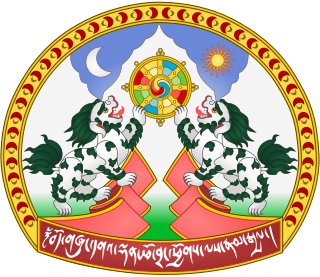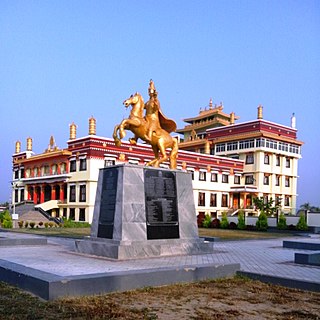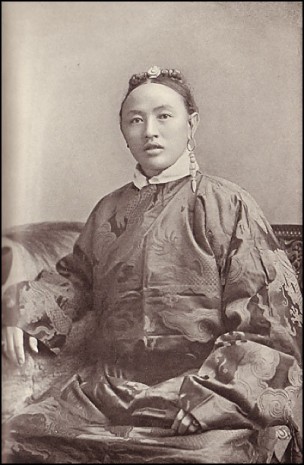
The Central Tibetan Administration is a non-profit political organization based in Dharamshala, India. Its organization is modeled after an elective parliamentary government, composed of a judiciary branch, a legislative branch, and an executive branch, and is sometimes labelled as a government in exile for Tibet.

Jetsun Pema is the sister of the 14th Dalai Lama. For 42 years she was the President of the Tibetan Children's Villages (TCV) school system for Tibetan refugee students.

Ngapoi Ngawang Jigme was a Tibetan senior official who assumed various military and political responsibilities both before and after 1951 in Tibet. He is often known simply as Ngapo in English sources.

Tempa Tsering.

The Sikyong is the political leader of the Central Tibetan Administration, a Tibetan exile organisation in India also known as the Tibetan Government-in-Exile based on the 2011 Charter of Tibetans-in-exile. The title was created in 2012 after the 14th Dalai Lama decided not to assume any political and administrative authority as the head of the Tibetan Administration for Tibetans-in-exile.

Tsepon Wangchuk Deden Shakabpa was a Tibetan nobleman, scholar, statesman and former Finance Minister of the government of Tibet.

The Tibetan Parliament in Exile (TPiE), officially the Parliament of the Central Tibetan Administration, is the unicameral and highest legislative organ of the Central Tibetan Administration, the government-in-exile of the Tibet Autonomous Region of China. It was established and is based in Dharamshala, India. The creation of this democratically elected body has been one of the major changes that the 14th Dalai Lama brought about in his efforts to introduce a democratic system of administration.

The Kashag was the governing council of Tibet during the rule of the Qing dynasty and post-Qing period until the 1950s. It was created in 1721, and set by Qianlong Emperor in 1751 for the Ganden Phodrang in the 13-Article Ordinance for the More Effective Governing of Tibet. In that year the Tibetan government was reorganized after the riots in Lhasa of the previous year. The civil administration was represented by the Council (Kashag) after the post of Desi was abolished by the Qing imperial court. The Qing imperial court wanted the 7th Dalai Lama to hold both religious and administrative rule, while strengthening the position of the High Commissioners.

The Tibetan diaspora are the diaspora of Tibetan people living outside Tibet.

Tethong Tenzin Namgyal is a Tibetan politician and a former Prime Minister of Central Tibetan Administration.
Tsering Wangchuk, is a Tibetan politician and physician serving as the Kalon for Health of the Central Tibetan Administration since 2011.

Shatra, was a Tibetan politician.

The Ganden Phodrang or Ganden Podrang was the Tibetan system of government established by the 5th Dalai Lama in 1642, after the Oirat lord Güshi Khan who founded the Khoshut Khanate conferred all temporal power on the 5th Dalai Lama in a ceremony in Shigatse in the same year. Lhasa again became the capital of Tibet, and the Ganden Phodrang operated until the 1950s. The Ganden Phodrang accepted China's Qing emperors as overlords after the 1720 expedition, and the Qing became increasingly active in governing Tibet starting in the early 18th century. After the fall of the Qing empire in 1912, the Ganden Phodrang government lasted until the 1950s, when Tibet was annexed by the People's Republic of China. During most of the time from the early Qing period until the end of Ganden Phodrang rule, a governing council known as the Kashag operated as the highest authority in the Ganden Phodrang administration.

Tibet under Qing rule refers to the Qing dynasty's rule over Tibet from 1720 to 1912. The Qing rulers incorporated Tibet into the empire along with other Inner Asia territories, although the actual extent of the Qing dynasty's control over Tibet during this period has been the subject of political debate. The Qing called Tibet a fanbu, fanbang or fanshu, which has usually been translated as "vassal", "vassal state", or "borderlands", along with areas like Xinjiang and Mongolia. Like the preceding Yuan dynasty, the Manchus of the Qing dynasty exerted military and administrative control over Tibet, while granting it a degree of political autonomy.

Alak Jigme Thinley Lhundup or Alak Jigme Lhundup Rinpoche was a Tibetan Tulku, as well as the former speaker of the Tibetan Parliament in Exile and former Minister with the exile Tibet administration.
The Tibet Bureau in Paris, one of the offices of the official representation of the 14th Dalai Lama and of the Tibetan government in exile, is in charge of France, the Iberian Peninsula, the Maghreb and the Benelux countries. Founded in September 1992 it acts as an Embassy.

Lobsang Nyandak, sometimes written Lobsang Nyendak also called Lobsang Nyandak Zayul is a Tibetan diplomat and politician. born in 1965 in Kalimpong, India where he performed his studies in Herbertpur and at Panjab University in Chandigarh. There, he held functions at Tibetan Youth Congress before becoming the founding Executive Director of the Tibetan Centre for Human Rights and Democracy. Member of the National Democratic Party of Tibet, he was elected deputy and was selected as a minister by Samdhong Rinpoche, the first elected Kalon Tripa of Central Tibetan Administration (CTA). He then was the Representative of the 14th Dalai Lama to the Americas and became president of The Tibet Fund.
The Tibet Policy Institute (TPI), founded in 2012, is a Tibetan think tank and research-oriented intellectual institute of the Central Tibetan Administration. TPI is based in Dharamshala, Himachal Pradesh, India.

Penpa Tsering is a Tibetan politician based in India. He is the second democratically elected Sikyong of the Central Tibetan Administration in India. He succeeded the last Sikyong Lobsang Sangay on 27 May 2021. Penpa Tsering was the speaker of the Parliament of the Central Tibetan Administration for two terms between 2008 and 2016.

Thubten Samphel was a Tibetan writer, journalist, and government official. He worked as a secretary in the Ministry of Foreign Affairs and was a spokesperson of the Central Tibetan Administration, based in Dharamshala. He also worked for the administration's think tank, Tibet Policy Institute.
















